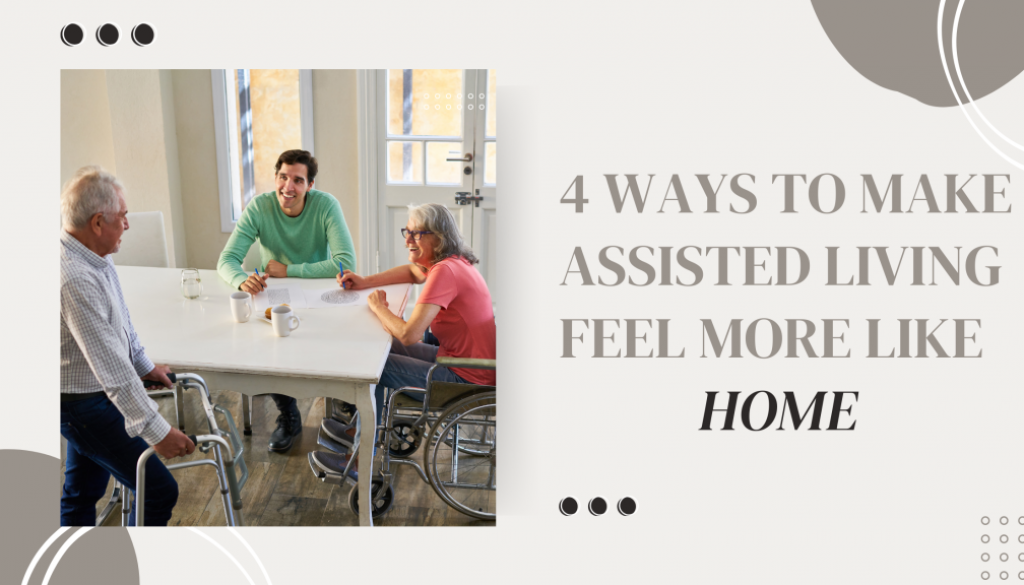4 Ways to Make Assisted Living Feel More Like Home
By Maureen Rulison
Caregiver Support and Resources, LLC
Moving into an assisted living community, nursing home (or any other long-term facility) can be an extremely difficult decision. The main goal? Receive top-notch care while making it feel like home.
Last time, we addressed the preparations that should be made – as part of a great life-care plan – to ease stress BEFORE the move. Now, we’re taking time to address the move itself, the little things everyone can do to make the new digs feel how they’re supposed to.
Like home.
Assisted Living: Creating ‘No Place Like Home’
There’s no place like an actual home, but roughly 70% of U.S. seniors eventually require some level of long-term care. There are pros, cons and other factors to weigh in the decision-making process. Hopefully you’ve made the best possible decision that ensures compassionate care, dignity and foresight – for good health and bad.
Our loved ones and care partner teams can ease the transition by making the new dwelling feel like home right from start. It doesn’t have to feel like living in rented space. Your loved one may require advanced care that couldn’t easily be provided anywhere else. But their assisted living space can really become home — a place to feel comfortable, nurtured, honored and safe.
1. Add Personal Flair
Everybody has a personal style, whether it’s obvious or not. We have our own preferences for how our spaces must look and feel. We understand why some say assisted living feels like a hotel. They’re generally designed to be sensible and appealing to what most would consider “comfortable.” (Nursing homes and other advanced care facilities may feel like full-fledged hospital environments.)
But residents have power. They can choose. They can include decorative items, pictures, cherished heirlooms and anything else their little hearts desire.
Change the aesthetics. Decorate, decorate, decorate! Add a favorite scented candle, some prized sports memorabilia, and/or items professing their religious faith. How about their favorite art and music? We prioritize person-centered care for a reason. It honors and empowers the person at the center of care.
2. Get Involved
Becoming connected with new friends and participating in activities can help folks feel welcome in a new place. It helps to avoid feeling isolated and depressed – which studies say affects many long-term care residents and actually precipitates worse health outcomes.
Moving to assisted living, it can be tempting for some to stay in their room, especially if they’re shy. Your loved one may naturally feel life has changed for the worse. But it doesn’t have to be that way!
Socialization can be the perfect medicine. Some really simple ways to become involved include eating in common areas, chatting with fellow residents and staff, being a good neighbor, and welcoming visitors. Feeling bold? Take a peek at the community events calendar – there are almost always special trips, sporting events, museum visits and festivals outside the facility, and other internal events like board games, card nights, Bingo and so much more!
3. Stay Connected to Family & Memories
Hopefully, your loved one’s move to assisted living is just another step to many great memories to come. Family and friends can AND SHOULD continue to be involved. We all should be able to continue enjoying fulfilling, meaningful and engaging relationships for A LIFE WORTH LIVING.
But reality tells us family and friends can’t always be there. That’s OK! Connection can be found anywhere these days.
Photos evoke feelings of connection to those we care about most – especially for our loved ones living with dementia. Choose a few favorites to hang on the wall. Fill a large tabletop album or scrapbook with snapshots of yesteryear. Include memories of special occasions, travel or vacations, friends, family and beloved pets.
Technology is being used increasingly to facilitate communication and store memories. Digital picture frames cycle through hundreds or even thousands of cherished photographs. Loved ones may compile music playlists on Alexa (like the ones my life partner/care partner, Brian, uses to bring clarity to foggy moments with dementia). A lot of adults entering assisted living today have been texting for years. A quick text, call or FaceTime with the grandkids often means more than words could express.
4. Call It Home
Call it what it is. Call it home.
There’s no better way to make senior living feel like home than to call it home. Whether you’re moving into independent living, assisted living or a skilled-nursing home, refer to the new space as home as often as possible.
Yes, it’s a new space. It might not feel like home right away. That’s also OK! But words matter. They allow us to make sense of new environments – to be comfortable knowing we’re cared for and that our needs are being met.
That’s the essence of home.
Be Patient & Positive: Assisted Living Can and Will Feel Like Home
During this process, remember to be patient with yourself, loved ones and the rest of the care-partner team. Moving to assisted living is an adjustment. We can’t expect to feel at home immediately. It’s a brand-new space that just begs US to make it what we want it to be.
Rest assured, as time goes by, your loved one will settle and become more comfortable. Of course, life-care planning gets everyone ready for all the changes – big and small.
Caregiver Support and Resources, LLC has over 25 years of experience with all aspects of life-care planning, including Board-certified Patient Advocacy, Medicaid Planning & Asset Protection, Referral Services and #WeAreDementiaStrong. We’re happy to guide the process in a caring and compassionate way.




